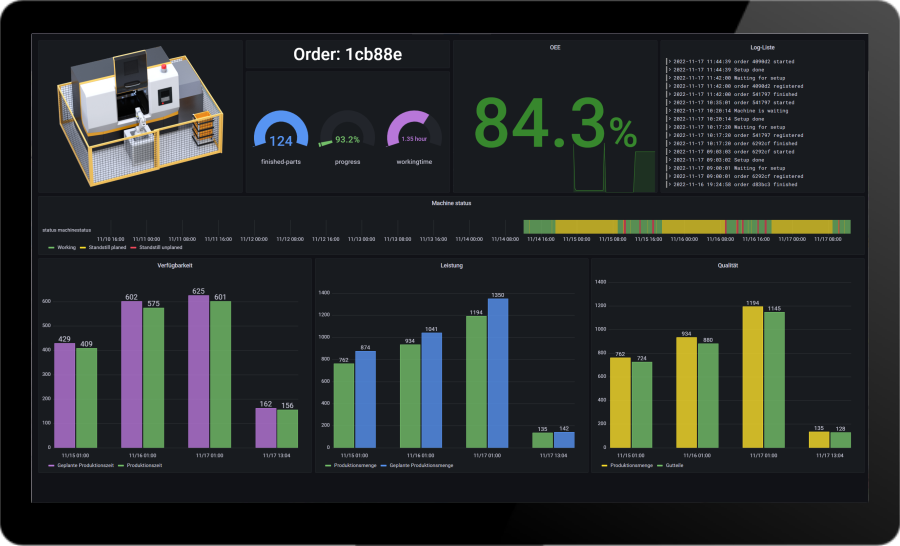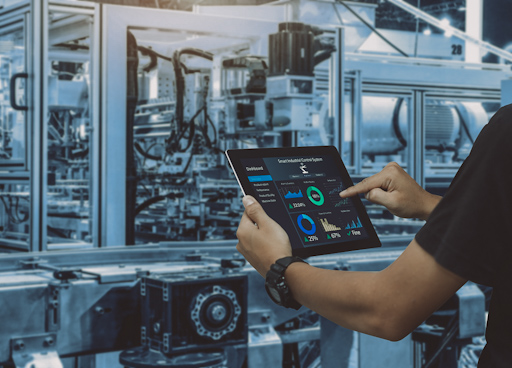Communication protocols and industry standards

BITMOTECO Machine Monitoring
Our modular condition monitoring system for production supports a wide range of communication protocols and industry standards.
Arrange a demo appointment now to coordinate your test operation.
Added value at a glance
In modern industry , efficient and reliable communication plays a decisive role in the smooth running of processes and the optimization of production workflows. The use of standardized and efficient communication protocols and industry standards ensures optimal cooperation between different components and also enables companies to reduce costs, optimize production and improve quality. Communication protocols therefore serve as invisible architects of information exchange. They define the rules and procedures by which different industrial devices, machines and systems can communicate and cooperate with each other. A well-established interface based on industry standards and norms is essential to ensure seamless interaction and thus ensure the compatibility of different components. The following are the basic concepts of Communication protocols and industry standards in industry and their significance for the modernization, efficiency increase and safety of industrial processes is explained.
Definition and classification
The following is a brief outline of the four basic terms for further understanding of the topic of communication protocols and industry standards:
Communication Protocols
Communication protocols are set of rules and procedures that allow the exchange of data as well as information between different systems, devices, and even computers. They serve as a common language and structure for the smooth exchange of information and interaction between the components involved. Communication protocols thus define how data is formatted, sent, received, verified, and interpreted to ensure that communication is not only efficient, but also reliable and error-free.
Interface
In terms of communication protocols, an interface is a physical or logical connection between two systems through which data exchange takes place. Accordingly, one interface allows access to the functions and services of one system or device by another, often based on the implementation of certain protocols and connections.
Industry
An industry standard is a uniform regulation that is recognized and widely used by an industry or technology area. These standards are often set by trade associations, standardization bodies or international organizations and then serve as the basis for the development, operation and interoperability of e.g. products, technologies and systems in a specific industry.
Industry
An industry standard is a specific regulation or guideline that is used in a specific industry or area of application. These standards contain correspondingly detailed technical specifications, procedures or requirements that are relevant to the production and operation, as well as the safety or quality of products and services. Industry standards can be developed and enacted by both governmental and independent organizations to ensure consistent practice and performance across a specific industry.
Communication Protocols and Industry Standards: Features at a Glance
Communication protocols and industry standards enable the smooth exchange of information between different systems and devices and are thereforeindispensable sets of rules in the industry. FThere are typical, characteristic characteristics of communication protocols that must be taken into account when making a selection. This will help you identify the most appropriate protocol for your use case.
- Standardization: Indicates whether the protocol has an official, recognized standard or industry standard to ensure interoperability.
- Data Transfer Rate: The speed at which data can be transmitted over the protocol, measured in bits per second (bps) or kilobits per second (Kbps), etc.
- Latency: The delay between sending a message and then receiving a response over the protocol.
- Reliability: The ability of the protocol to transmit data without errors and in the correct order, as well as the availability and robustness of the protocol.
- Scalability: The protocol’s ability to handle an increasing number of devices and users without significantly impacting performance.
- Security: The security mechanisms that the protocol implements to protect data from unauthorized access, manipulation or theft, for example.
- Complexity: The difficulty and complexity of implementing and maintaining the protocol.
- Supported topologies: The network topologies that the protocol supports, such as point-to-point, star, ring, etc.
- Supported media: The different types of physical media through which the protocol can communicate, such as copper cables, fiber, or wireless connections.
- Protocol layers: The hierarchy of protocol layers used to transfer the data from the application layer to the physical layer.
- Real-time capability: The ability of the protocol to transmit data in real-time. This can sometimes be crucial in some industrial applications.
- Energy Efficiency: The ability of the protocol to optimize energy consumption in battery-powered devices or wireless sensor networks.
- Dissemination and acceptance: The dissemination and acceptance of the protocol in industry and other areas of application.
- Cost: The cost of implementing, operating, and maintaining the protocol.
Communication Protocol Topologies
In industry, different network topologies are developed in terms of Communication protocols and industry standards to enable networking and communication between devices and systems. These topology shapes can be selected and then implemented according to the requirements and complexity of the industrial network. Each topology has its own advantages and disadvantages in terms of scalability, redundancy, emerging costs, and communication efficiency. The choice of the right topology therefore depends on the specific applications, the communication needs and the spatial conditions in the industrial environment.
- Point-to-point: A direct connection between two endpoints, where communication only takes place between these two devices.
- Star: A central device, such as a switch or hub, is connected to all other devices on a network. All communication channels run through this central device.
- Ring (ring): The devices are connected to each other in a closed loop so that the data circulates in a specific direction.
- Bus (Bus): All devices are connected to a common transmission medium (bus). The data is sent to all devices in the network. Furthermore, each device decides whether to process or discard the data it receives.
- Tree: A hierarchy of devices where there is a central unit or root from which several child devices or branches are connected.
- Mesh: Each device is directly connected to every other device on the network. This creates a redundant network with a correspondingly diverse range of communication paths.
- Line: The devices are connected one after the other in a linear arrangement so that communication runs from one endpoint to another.
- Hybrid: A combination of different topologies to take advantage of multiple structures and ensure optimal communication.

Communication protocols in industry
Depending on the area of application and technological context, a variety of communication protocols and industry standards can be found in the industry . their commitment. The following list represents only a few of the most important communication protocols that are now widely used in industry:
- Modbusis a serial communication standard that is widely used in industrial automation. It enables communication between higher-level control systems and various field devices, such as sensors and actuators.
- MQTT (Message Queuing Telemetry Transport) is a lightweight, reliable and efficient messaging protocol used in M2M communication as well as IIoT (Industrial Internet of Things).
- IO-Link is a manufacturer-independent point-to-point communication protocol for digital data exchange between sensors and actuators and a higher-level control level. It enables efficient and intelligent communication with simple wiring. In addition, it offers extensive diagnostic options.
- MTConnect is an open, standardized communication standard used in the manufacturing industry. It serves to improve interoperability and data communication between machines, tools and higher-level systems. It also enables the acquisition and transmission of machine data in real time. In this way, it ultimately supports the production monitoring, analysis and optimisation of production processes.
- OPC UA (Open Platform Communications Unified Architecture) is an open and platform-independent communication standard used in industrial automation and the Internet of Things (IoT).
- HTTP (Hypertext Transfer Protocol) and REST (Representational State Transfer) are widely used for communication in web applications and IoT devices. They enable the exchange of data and resources via the Internet and thus offer a standardized and flexible communication structure.
- Profibus is a widely used fieldbus protocol used in factory automation and process control. It supports fast transfer of data between different devices.
- Ethernet/IP is an implementation of the Ethernet protocol in industrial environments. The protocol enables seamless integration of Ethernet-based devices into industrial networks.
- PROFINET is a real-time Ethernet protocol used in automation technology. It supports real-time communication between control systems, I/O devices, and other industrial components.
- DeviceNet is a network protocol for connecting sensors and actuators to a higher-level control system. It is widely used in factory automation.
- HART (Highway Addressable Remote Transducer) is a hybrid analog-digital communication protocol that enables communication with intelligent field devices in process automation.
- CAN (Controller Area Network) is a reliable serial-based communication protocol used in the automotive industry, but also in industrial automation.
- WirelessHART is a wireless communication protocol based on the HART standard that is used in process automation to enable wireless communication with field devices.
- EtherCAT (Ethernet for Control Automation Technology) is a real-time Ethernet protocol used in automation technology. It enables fast and deterministic communication between control systems and distributed field devices.
- BACnet (Building Automation and Control Networks) is a protocol used in building automation to enable communication between various devices and systems in buildings. It supports the monitoring and control of building technology, such as heating, ventilation, air conditioning and lighting.
- RS232 and RS485 are serial communication standards that are often used in industry to communicate between control systems, sensors and actuators. RS232 is suitable for point-to-point connections, while RS485 is used for multi-drop communications.
- Fanuc Focas is a proprietary protocol used by Fanuc control systems to enable communication between CNC machines and external devices or even software applications. It supports bi-directional data exchange and remote control of the machines.
In addition, there are many other industrial communication protocols that have been developed for specific applications and industries. Choosing the appropriate protocol depends on the specific requirements and goals of an industrial system or process.
Areas of application in industry
Communication protocols and industry standards are used in industry in a wide range of applications to enable data transmission and information exchange between different devices, machines, and systems. The following examples provide an initial overview:
- Machine control and automation: Communication protocols enable the control and monitoring of machines and industrial plants. They facilitate the exchange of e.g. control commands, status information and operating data between control systems and the respective machine components.
- Process Automation: In the process industry (e.g. in the chemical, petrochemical or pharmaceutical industries), protocols enable communication between sensors, actuators and control systems in order to monitor and control complex processes.
- Data monitoring and analysis: Communication protocols are used to record and transmit production data and operating conditions, which are crucial for analysis, fault diagnosis and efficiency optimization.
- Remote maintenance and remote access: By using communication protocols, technicians and engineers can even remotely access industrial equipment and systems, as well as diagnose and perform maintenance. As a result, this saves time and money.
- Robotics and Automated Guided Vehicles (AGVs): Communication protocols enable communication between robots, AGVs and the control systems to perform complex tasks in industrial manufacturing and logistics.
- Energy monitoring and optimisation: Logs are used to collect and analyze energy consumption data from machinery and equipment. This makes it possible to implement energy efficiency measures, which ultimately leads to a reduction in energy costs.
- Building automation: In building automation, communication protocols enable the networking and control of e.g. lighting, heating, ventilation, air conditioning and security systems. As a result, energy consumption is optimized, which improves consumer comfort.
- Supply Chain Management: Communication protocols support communication and data exchange between different partners along the supply chain. This ensures efficient and transparent logistics.
- Asset Management: Logs are used to collect and transmit data on the maintenance status and histories of industrial plants and equipment in order to optimize the lifecycle of assets and minimize downtime.
- Quality assurance: Communication protocols enable the exchange of data between measurement and testing systems and can thus record quality data. Process errors can then be identified and product quality can be improved.




Connecting communication protocols in industry
The interconnection of communication protocols in industrial use plays a crucial role in ensuring interoperability and communication between different systems and components. Industrial environments often use different communication protocols that are specifically designed for specific applications or devices. The challenge is to connect these heterogeneous protocols together so that data can be exchanged seamlessly. By implementing gateway solutions, protocol converters, or middleware systems, data can be transformed and transferred from one protocol to another. The coupling of communication protocols enables efficient integration of existing systems, collaboration between different devices and central data collection. As a result, companies can increase the performance of their industrial processes, reduce production costs, and optimize data analysis for better decision-making. A well-thought-out coupling of communication protocols opens up opportunities for improved automation, process optimization and the implementation of Industry 4.0 initiatives.
More on the topic:
Hannover | Niedersachsen | Oldenburg | Osnabrück | Göttingen | Celle | Lüneburg | Hameln | Aurich | Leer | Diepholz | Emsland | Gifhorn | Uelzen | Cuxhaven | Hamburg | Bremen | Braunschweig |
